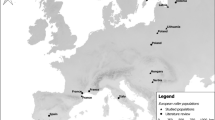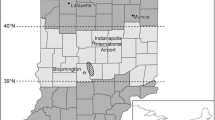Abstract
Phenological studies have demonstrated changes in the timing of seasonal events across multiple taxonomic groups as the climate warms. Some northern European migrant bird populations, however, show little or no significant change in breeding phenology, resulting in synchrony with key food sources becoming mismatched. This phenological inertia has often been ascribed to migration constraints (i.e. arrival date at breeding grounds preventing earlier laying). This has been based primarily on research in The Netherlands and Germany where time between arrival and breeding is short (often as few as 9 days). Here, we test the arrival constraint hypothesis over a 15-year period for a U.K. pied flycatcher (Ficedula hypoleuca) population where laying date is not constrained by arrival as the period between arrival and breeding is substantial and consistent (average 27 ± 4.57 days SD). Despite increasing spring temperatures and quantifiably stronger selection for early laying on the basis of number of offspring to fledge, we found no significant change in breeding phenology, in contrast with co-occurring resident blue tits (Cyanistes caeruleus). We discuss possible non-migratory constraints on phenological adjustment, including limitations on plasticity, genetic constraints and competition, as well as the possibility of counter-selection pressures relating to adult survival, longevity or future reproductive success. We propose that such factors need to be considered in conjunction with the arrival constraint hypothesis.

Similar content being viewed by others
References
Ahola M, Laaksonen T, Sippola K, Eeva T, Rainio K, Lehikoinen E (2004) Variation in climate warming along the migration route uncouples arrival and breeding dates. Glob Change Biol 10:1610–1617
Bibby CJ, Burgess ND, Hill DA, Mustoe SH (2000) Bird census techniques, 2nd edn. Academic, London
Both C, Visser ME (2001) Adjustment to climate change is constrained by arrival date in a long-distance migrant bird. Nature 411:296–298
Both C, Artemyev AV, Blaauw B, Cowie RJ, Dekhuijzen AJ, Eeva T, Enemar A, Gustafsson L, Ivankina EV, Järvinen A, Metcalfe NB, Nyholm NEI, Potti J, Ravussin P-A, Sanz JJ, Silverin B, Slater FM, Sokolov LV, Torok J, Winkel W, Wright J, Zang H, Visser ME (2004) Large-scale geographical variation confirms that climate change causes birds to lay earlier. Proc R Soc Lond B 271:1657–1662
Both C, Bouwhuis S, Lessells CM, Visser ME (2006) Climate change and population declines in a long-distance migratory bird. Nature 441:81–83
Both C, van Turnhout CAM, Bijlsma RG, Siepel H, van Strien AJ, Foppen RPB (2009) Avian population consequences of climate change are most severe for long-distance migrants in seasonal habitats. Proc R Soc Lond B (in press)
Buse A, Dury SJ, Woodburn RJW, Perrins CM, Good JEG (1999) Effects of elevated temperature on multi-species interactions: the case of pedunculate oak, winter moth and tits. Funct Ecol 13:74–82
Butler CJ (2003) The disproportionate effect of global warming on the arrival dates of short-distance migratory birds in North America. Ibis 145:484–495
Charmantier A, McCleery RH, Cole LR, Perrins C, Kruuk LEB, Sheldon BC (2008) Adaptive phenotypic plasticity in response to climate change in a wild bird population. Science 320:800–803
Coppack T, Both C (2002) Predicting life-cycle adaptation of migratory birds to global climate change. Ardea 90:369–378
Cotton PA (2003) Avian migration phenology and global climate change. Proc Acad Nat Sci Philadelphia 100:12219–12222
Crick HQP, Sparks TH (1999) Climate change related to egg-laying trends. Nature 399:423–424
DeWitt TJ, Sih A, Wilson DS (1998) Costs and limits of phenotypic plasticity. Trends Ecol Evol 13:77–81
Dhondt AA (2001) Trade-offs between reproduction and survival in tits. Ardea 89:155–166
Falconer DS, Mackay TFC (1996) Introduction to quantitative genetics, 4th edn. Longman, London
Gloucestershire Ornithological Co-ordinating Committee (1990–2004) Gloucestershire bird report (annual publication). GOCC, Gloucester
Goodenough (2008) Factors influencing nest-site choice and reproductive success in Cyanistes caeruleus (blue tit), Parus major (great tit) and Ficedula hypoleuca (pied flycatcher). PhD Thesis, University of Gloucestershire, U.K.
Goodenough AE, Elliot SL, Hart AG (2009a) The challenges of conservation for declining migrants: are reserve-based initiatives during the breeding season appropriate for the pied flycatcher Ficedula hypoleuca? Ibis 151:429–439
Goodenough AE, Elliot SL, Hart AG (2009b) Are nest sites actively chosen? Testing a common assumption for three non-resource limited birds. Acta Oecol 35:598–602
Gwinner E (1996) Circannual clocks in avian reproduction and migration. Ibis 138:47–63
Laaksonen T, Ahola M, Eeva T, Väisänen RA, Lehikoinen E (2006) Climate change, migratory connectivity and changes in laying date and clutch size of the pied flycatcher. Oikos 114:277–290
Lack DL (1954) The natural regulation of animal numbers. Clarendon, Oxford
Lack DL (1966) Population studies of birds. Clarendon, London
Lundberg A, Alatalo RV (1992) The pied flycatcher. Poyser, London
Møller AP, Rubolini D, Lehikoinen E (2008) Populations of migratory bird species that did not show a phenological response to climate change are declining. Proc Natl Acad Sci USA 105:16195–16200
Moore FR, Smith RJ, Sandberg R (2005) Stopover ecology of intercontinental migrants: en route problems and consequences for reproductive performance. In: Greenberg R, Marra PP (eds) Birds of two worlds: the ecology and evolution of migration. Johns Hopkins University Press, Baltimore
Nilsson J-Å, Svensson E (1996) The cost of reproduction: a new link between current reproductive effort and future reproductive success. Proc R Soc Lond B 263:711–714
Parmesan C, Yohe G (2003) A globally coherent fingerprint of climate change impacts across natural systems. Nature 421:37–42
Perrins CM, McCleery RH (1989) Laying dates and clutch size in the great tit. Wilson Bull 101:236–253
Pigliucci M (2005) Evolution of phenotypic plasticity: where are we going now? Trends Ecol Evol 20:481–486
Przybylo R, Sheldon BC, Merilä J (2000) Climatic effects on breeding and morphology: evidence for phenotypic plasticity. J Anim Ecol 69:395–403
Reuter H, Breckling B (1999) Emerging properties on the individual level: modelling the reproduction phase of the European robin Erithacus rubecula. Ecol Model 121:199–219
Sanz JJ, Potti J, Moreno J, Merino S, Frías O (2003) Climate change and fitness components of a migratory bird breeding in the Mediterranean region. Glob Chang Biol 9:461–472
Sparks TH (1999) Phenology and the changing pattern of bird migration in Britain. Int J Biometeorol 42:134–138
Sparks TH, Roberts DR, Crick HQP (2001) What is the value of first arrival dates of spring migrants in phenology? Avian Ecol Behav 7:75–85
Sparks TH, Bairlein F, Bojarinova JG, Hüppop O, Lehikoinen EA, Rainio K, Sokolov LV, Walker D (2005) Examining the total arrival distribution of migratory birds. Glob Chang Biol 11:22–30
Sparks TH, Huber K, Bland RL, Crick HQP, Croxton PJ, Flood J, Loxton RG, Mason CF, Newnham JA, Tryjanowski P (2007) How consistent are trends in arrival (and departure) dates of migrant birds in the UK? J Ornithol 148:503–511
Stenseth NC, Mysterud A (2002) Climate, changing phenology, and other life-history traits: non-linearity and match-mismatch to the environment. Proc Natl Acad Sci USA 99:13379–13381
Svensson E, Nilsson J-Å (1995) Food supply, territory quality, and reproductive timing in the blue tit (Parus caeruleus). Ecology 76:1804–1812
Tøttrup AP, Thorup K, Rahbek C (2006) Patterns of change in timing of spring migration in North European songbird populations. J Avian Biol 37:84–92
Tryjanowski P, Kuzniak S, Sparks TH (2005) What affects the magnitude of change in first arrival dates of migrant birds? J Ornithol 146:200–205
van der Jeugd HP, McCleery R (2002) Effects of spatial autocorrelation, natal philopatry and phenotypic plasticity on the heritability of laying date. J Evol Biol 15:380–387
Visser ME, Adriaensen F, van Balen JH, Blondel J, Dhondt AA, van Dongen S, du Feu C, Ivankina EV, Kerimov AB, de Laet J, Matthysen E, McCleery RH, Orell M, Thomson DL (2003) Variable responses to large-scale climate change in European Parus populations. Proc R Soc Lond B 270:367–372
Acknowledgements
We thank the RSPB and Nagshead nestbox monitors for providing data and the three individuals who reviewed an earlier draft of this paper for their helpful and constructive comments. This research was partially funded by the Gloucestershire Naturalists’ Society and the British Trust for Ornithology.
Author information
Authors and Affiliations
Corresponding author
Rights and permissions
About this article
Cite this article
Goodenough, A.E., Hart, A.G. & Elliot, S.L. What prevents phenological adjustment to climate change in migrant bird species? Evidence against the “arrival constraint” hypothesis. Int J Biometeorol 55, 97–102 (2011). https://doi.org/10.1007/s00484-010-0312-6
Received:
Revised:
Accepted:
Published:
Issue Date:
DOI: https://doi.org/10.1007/s00484-010-0312-6




